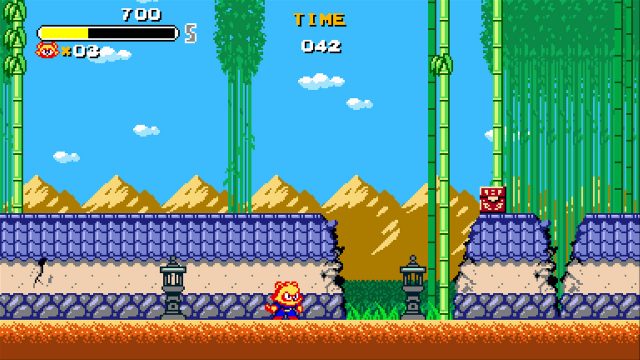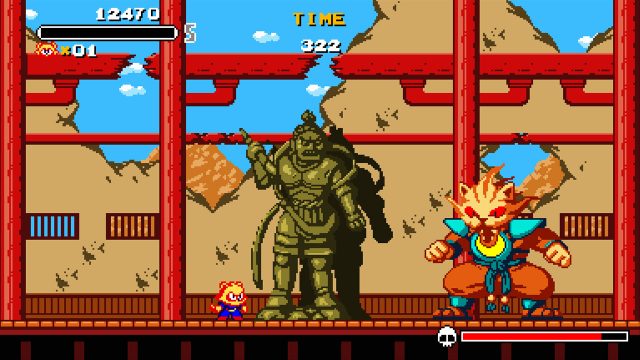Snappy, frantic run and gun action that satisfies even in short bursts; nails an oft-neglected flavor of 1980s nostalgia; starts mellow and will dish out as much punishment as the player is willing to take
Completely perfunctory story; not much to offer aside from brief arcade action
Someday, somebody will need to explain the France and Wonder Boy thing to me. In 2017, Paris-based Lizardcube releases a remake of Wonder Boy III: The Dragon’s Trap. In 2018, it’s Game Atelier, also based in Paris, with a new Wonder Boy sequel called Monster Boy and the Cursed Kingdom. And the same year, a solo developer with the extremely on-the-nose alias of Wonderboy Bobi gave the world a Wonder Boy homage, Aggelos. Now, Wonderboy Bobi is back with another title, Tanuki Justice.
Tanuki Justice is not a Wonder Boy game or homage, but is a retro game dripping with nostalgia for the same era — arcades of the mid to late 1980s. After the golden age of single screen classics like Pac-Man but before the the arrival of showstopper blockbusters like Final Fight and Street Fighter II, quarter munchers were often cute and summery. Think Out Run, New Zealand Story, and of course a Wonder Boy or two. Sprites were often cartoony, with flat but pleasant shading. The era is most remembered for Nintendo’s NES, and the NES aesthetic has been enthusiastically strip-mined for retro game style in the past decade, as seen in Shovel Knight, Axiom Verge, Panzer Paladin, and many more. Tanuki Justice is instead aping the bigger, brighter look of the era’s arcade hardware. Unlike Aggelos, Tanuki Justice is not taking its cues from a single game, but everything from the hitbox sizes to the flashing fonts to the music recalls the late 1980s.
Tanuki Justice is not the sort of game one plays for story, but for those who may be curious, the game stars two anthropomorphic tanukis (Japanese raccoon dogs), a boy in blue and a girl in green, who fight through various Japanese-inspired environments against many other anthropomorphic animals and thereby save the world from an evil plot. There really isn’t more to it than that, and even by the terse standards of 1980s run and gun games (Contra, Ghosts ‘n Goblins) this is a little underwhelming. Still, the premise does its job of providing engaging enemies to look at and destroy, so it doesn’t get in the way of the game’s essence.
This is not a game for everybody. It is a fairly difficult run and gun platformer, although if you’re comfortable with Cuphead you should be right at home here. The titular tanukis can throw ninja stars in eight directions, but their range is shorter than you might expect. You can pick up a ninja star power-up to increase the range, and you can pick up a shield power-up to absorb one hit. Without the shield, you die in one hit, and (assuming you have any extra lives) you respawn where you died, or on the closest safe ground if for example you fell down a pit. Lose all lives, and you will need to restart the stage, but you can continue as many times as you need to. As you attack enemies or pick up points, you’ll fill up a special attack meter that can be spent on a giant and super-damaging ninja star attack which also neutralizes enemy bullets. The meter fills quickly, so it’s part of the regular rhythm of combat, rather than just a panic button.
There are seven stages, or rather six full stages and a final boss, and three difficulties (Normal, Hard, Insane), plus a survival mode and at least one bonus mode I’ve discovered, the name of which will be withheld to preserve the surprise, but which is similar to Insane difficulty in its intensity. The main campaign can be played co-op. The stages are well-varied in terms of settings, enemies, environmental challenges, and so forth, and escalate well in difficulty. Like the era’s arcade games, the first stage or two lures you in with lower difficulty (at least on Normal mode) before shanking you and stealing your quarters.
Honestly, for a player familiar with the genre, Normal mode is not too tough. It’s tense and provides many opportunities to curse, but I beat the game twice within a few hours, and the second time without needing to continue. Hard mode and then Insane mode escalate significantly with new enemy configurations and some hardier enemies. I haven’t graduated to Insane mode yet, but Hard mode has been a nearly constant white-knuckle affair for me. If replaying an arcade-style game to tackle harder difficulties and better your scores sounds like a good time to you, the game has quite a bit to offer. On the other hand, if you tend to beat games on a single difficulty and then put them down, you might not feel satisfied with Tanuki Justice. In this way, of course, Tanuki Justice is similar to a number of arcade ports on Switch.
If all this talk of difficulty is off-putting, this might not be the game for you. Cuphead will be a better onramp for run and gun platformers, and is a masterpiece in its own right. At the same time, I don’t want to overstate the difficulty, at least on Normal mode. This is still significantly easier than many run and gun classics like Ghosts ‘n Goblins or Metal Slug. If the tension, pace, and feel of Cuphead appeal to you and you’re curious about something more streamlined and frantic, consider Tanuki Justice.
Nintendojo was provided a copy of this game for review by a third party, though that does not affect our recommendation. For every review, Nintendojo uses a standard criteria.




 ShareThis
ShareThis







